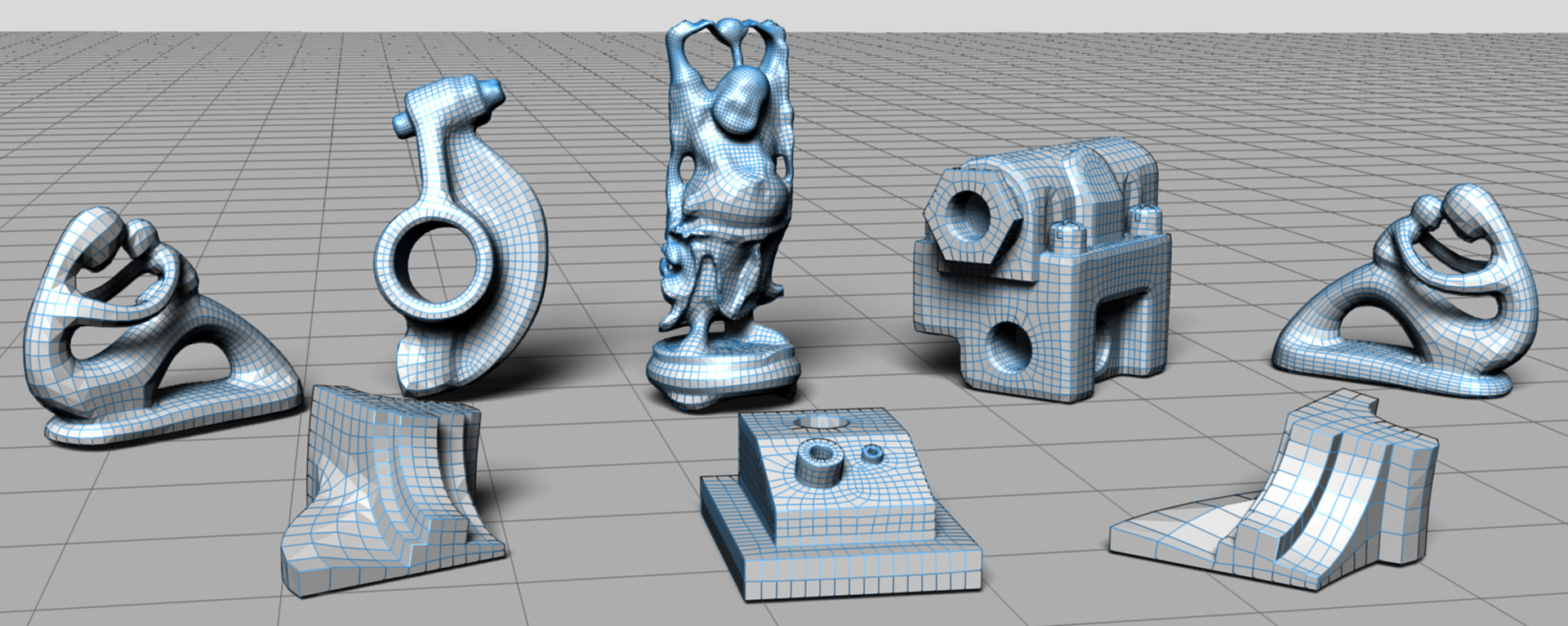“A wave-based anisotropic quadrangulation method” by Zhang, Huang, Liu and Bao
Conference:
Type(s):
Title:
- A wave-based anisotropic quadrangulation method
Presenter(s)/Author(s):
Abstract:
This paper proposes a new method for remeshing a surface into anisotropically sized quads. The basic idea is to construct a special standing wave on the surface to generate the global quadrilateral structure. This wave based quadrangulation method is capable of controlling the quad size in two directions and precisely aligning the quads with feature lines. Similar to the previous methods, we augment the input surface with a vector field to guide the quad orientation. The anisotropic size control is achieved by using two size fields on the surface. In order to reduce singularity points, the size fields are optimized by a new curl minimization method. The experimental results show that the proposed method can successfully handle various quadrangulation requirements and complex shapes, which is difficult for the existing state-of-the-art methods.
References:
1. Alliez, P., Cohen-Steiner, D., Devillers, O., Lévy, B., and Desbrun, M. 2003. Anisotropic polygonal remeshing. ACM Transactions on Graphics 22, 3, 485–493. Google ScholarDigital Library
2. Alliez, P., Ucelli, G., Gotsman, C., and Attene, M. 2005. Recent advances in remeshing of surfaces. Research report, [email protected] Network of Excellence.Google Scholar
3. Ben-Chen, M., Gotsman, C., and Bunin, G. 2008. Conformal flattening by curvature prescription and metric scaling. Computer Graphics Forum 27, 2, 449–458.Google ScholarCross Ref
4. Blackstock, D. T. 2000. Fundamentals Of Physical Acoustics. Wiley-interscience.Google Scholar
5. Boier-Martin, I., Rushmeier, H., and Jin, J. 2004. Parameterization of triangle meshes over quadrilateral domains. In Eurographics Symposium on Geometry Processing, ACM, New York, NY, USA, 193–203. Google ScholarDigital Library
6. Bommes, D., Zimmer, H., and Kobbelt, L. 2009. Mixed-integer quadrangulation. ACM Transactions on Graphics 28, 3, 1–10. Google ScholarDigital Library
7. Bremer, P.-T., Edelsbrunner, H., Hamann, B., and Pascucci, V. 2004. A topological hierarchy for functions on triangulated surfaces. IEEE Transactions on Visualization and Computer Graphics 10, 385–396. Google ScholarDigital Library
8. Cohen-Steiner, D., and Morvan, J.-M. 2003. Restricted delaunay triangulations and normal cycle. In Symposium on Computational geometry, 312–321. Google ScholarDigital Library
9. Dong, S., Kircher, S., and Garland, M. 2005. Harmonic functions for quadrilateral remeshing of arbitrary manifolds. Comput. Aided Geom. Des. 22, 5, 392–423. Google ScholarDigital Library
10. Dong, S., Bremer, P.-T., Garland, M., Pascucci, V., and Hart, J. C. 2006. Spectral surface quadrangulation. ACM Transactions on Graphics 25, 3, 1057–1066. Google ScholarDigital Library
11. Edelsbrunner, H., Harer, J., and Zomorodian, A. 2001. Hierarchical morse complexes for piecewise linear 2-manifolds. In Symposium on Computational geometry, ACM, New York, NY, USA, 70–79. Google ScholarDigital Library
12. Hormann, K., Polthier, K., and Sheffer, A. 2008. Mesh parameterization: theory and practice. In SIGGRAPH Asia courses, ACM, New York, NY, USA, 1–87. Google ScholarDigital Library
13. Huang, J., Zhang, M., Ma, J., Liu, X., Kobbelt, L., and Bao, H. 2008. Spectral quadrangulation with orientation and alignment control. ACM Transactions on Graphics 27, 5, 1–9. Google ScholarDigital Library
14. Kälberer, F., Nieser, M., and Polthier, K. 2007. Quadcover – surface parameterization using branched coverings. Computer Graphics Forum.Google Scholar
15. Lai, Y.-K., Kobbelt, L., and Hu, S.-M. 2008. An incremental approach to feature aligned quad dominant remeshing. In ACM symposium on Solid and physical modeling, ACM, New York, NY, USA, 137–145. Google ScholarDigital Library
16. Marinov, M., and Kobbelt, L. 2006. A robust two-step procedure for quad-dominant remeshing. Computer Graphics Forum 25, 3 (Sept.), 537–546.Google ScholarCross Ref
17. Meyer, M., Desbrun, M., Schröder, P., and Barr, A. H. 2002. Discrete differential-geometry operators for triangulated 2-manifolds. In Visualization and Mathematics III, H.-C. Hege and K. Polthier, Eds. Springer-Verlag, 35–57.Google Scholar
18. Palacios, J., and Zhang, E. 2007. Rotational symmetry field design on surfaces. ACM Transactions on Graphics 26, 3, 55. Google ScholarDigital Library
19. Polthier, K., and Preuss, E. 2003. Identifying vector field singularities using a discrete hodge decomposition. In Visualization and Mathematics III, H.-C. Hege and K. Polthier, Eds. Springer Verlag, Heidelberg, Germany, 113–134.Google Scholar
20. Ray, N., Li, W. C., Lévy, B., Sheffer, A., and Alliez, P. 2006. Periodic global parameterization. ACM Transactions on Graphics 25, 4, 1460–1485. Google ScholarDigital Library
21. Ray, N., Vallet, B., Li, W. C., and Lévy, B. 2008. Nsymmetry direction field design. ACM Transactions on Graphics 27, 2, 1–13. Google ScholarDigital Library
22. Tong, Y., Alliez, P., Cohen-Steiner, D., and Desbrun, M. 2006. Designing quadrangulations with discrete harmonic forms. In Eurographics Symposium on Geometry Processing, Eurographics Association, Aire-la-Ville, Switzerland, 201–210. Google ScholarDigital Library
23. Zhang, E., Mischaikow, K., and Turk, G. 2006. Vector field design on surfaces. ACM Transactions on Graphics 25, 4, 1294–1326. Google ScholarDigital Library





